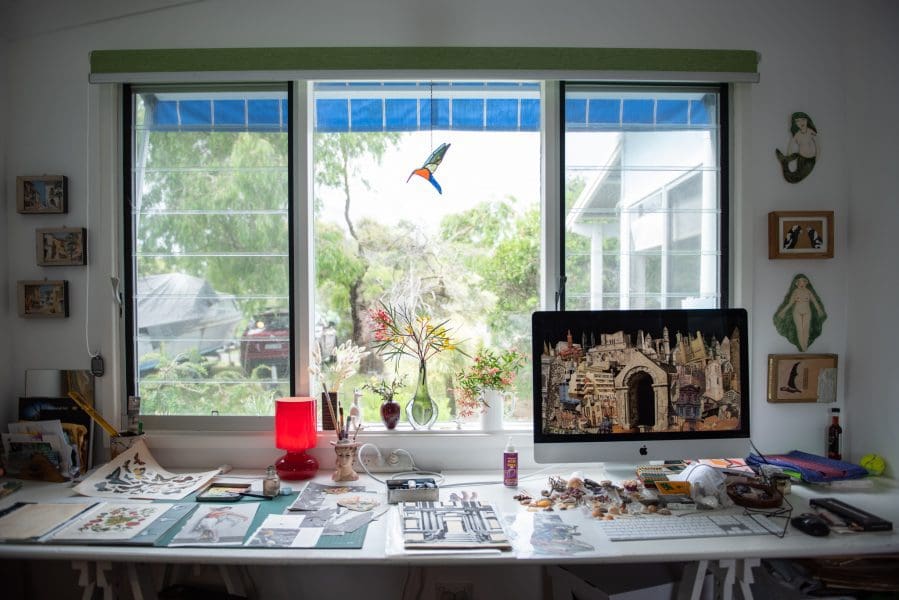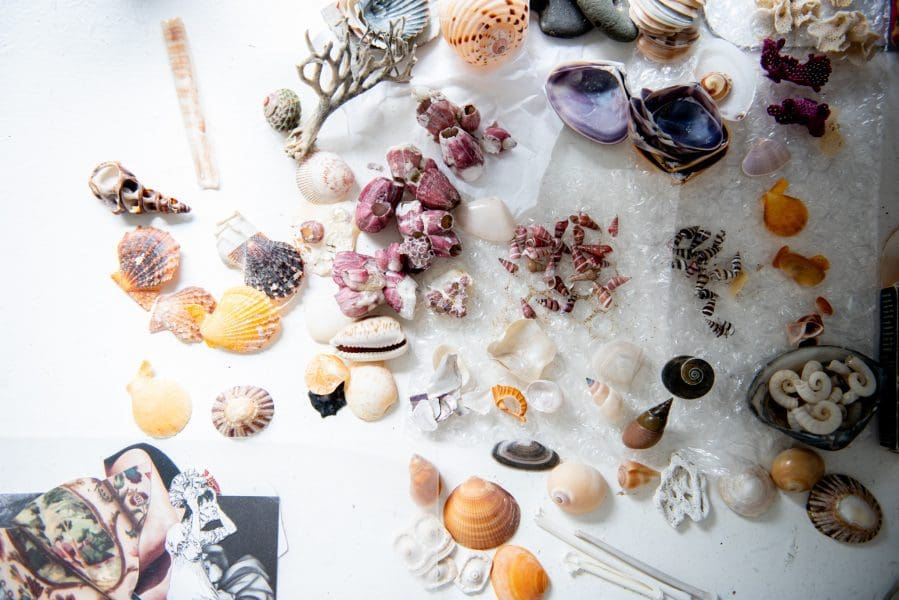
Piercing the veil
A new exhibition at Buxton Contemporary finds a rich complexity in the shadowy terrain between life and death.
Creating art that explores gender, identity, privilege and power, Deborah Kelly, who is perhaps best known for her cut-andpaste collages, has a peripatetic practice. Her home-base is an apartment in Bronte, in Sydney’s eastern suburbs, but she is just as likely to be found making work in Darwin or Denmark, and collaboratively online. For our studio visit, we found her at the fishing village of Currarong, New South Wales.
Kelly tells us why it was so important for her to have studio space during the pandemic, and she explains how her analogue collages inform her “real works.” These projects, which she describes as “big, epic, multi-part and multidisciplinary,” are, she says, “not exactly studio-based, at all.”
Place
Deborah Kelly: My studio practice has become very nomadic and portable. It’s really from necessity. Our apartment is pretty small and if I try to work there I have to completely pack up every night or else there is nowhere to eat. I must say, I don’t understand how Sydney artists on the whole afford studios.
Since I got the surprise gift of a Bundanon residency [based on the south coast of New South Wales], about 12 years ago, I apply for things that have studio time and space attached to them. Bundanon completely changed my life: it made me realise how much I needed a studio, which I didn’t know before. Actually, when Covid-19 hit I had just established my first autonomous studio in Sydney, or anywhere. And three weeks later I was kicked out because of the virus.
The biggest influence on me lately has been history: the times we’re living through, the pandemic. My partner and I left Sydney in March 2020 for Currarong, a tiny fishing village on the south coast of New South Wales. She co-owns a house here with her ex-partner that is big enough for me to have a workspace. I guess moving here was a mental health issue because I was supposed to be running face-to-face interdisciplinary art-making encounters with institutions around Australia. All of them were cancelled.
So, what I got to do in Currarong [March 2020– January 2021] was spin my wheels productively instead of just eating my own heart out as everything fell over. Another crucial thing about having somewhere to work during the pandemic was that my father was ill under lockdown in Melbourne. I was so worried I would never see him again. And I didn’t. So having a studio was important to distract myself while I lost my dad.

Process
I used to do collage as my fall-back position when I didn’t have funds to make bigger work. It’s funny to me that it has become what people think of when my work is mentioned. Curator after curator, when they contact me they say, “Can you do me some collages?” I come back and go, “Well, can I do them with like a hundred people over nine months with life-sized collage portraits of strangers?” Which was the project I did for the 19th Biennale of Sydney in 2014, No Human Being Is Illegal.
I kept working on that project for the next five years, touring Australia. My dad was my biggest fan–he actually posed naked for No Human Being Is Illegal and he came with me to many of the towns where I did the tour. He was a very old man, but he just loved being famous! I finally finished the project in London, in December 2019, on a commission from the Wellcome Trust [a research foundation based in London]. During the project I got to make such satisfying work, meet really interesting people, and make good friends in various regional centres.
What I think of as my real work happens outside the studio and in exchange with other humans.
But I guess the studio, and the kind of playing that I do there with analogue collage, must be where I am cooking up my, well, chutzpah really—to be able to collaborate with strangers and seek for them to change the course of the work. I mean, I really try to put myself in a frame of mind where I can get past my own stupid artistic ego and see where other people would take the work and to really encourage that. So, perhaps that playing in the studio is—spiritual practice isn’t the right way to put it—but it is maybe an ego-taming practice in a way.

Projects
At the moment I’m working on a big evolving project called CREATION that will be in The National at the MCA [Museum of Contemporary Art]. I’m trying to gather people to build a queer, science fiction, climate change religion together. You know, I did think founding a religion would be hard, but nobody mentioned the pandemic! So what will happen at the MCA depends on what we’re allowed to do given current restrictions.
A central part of CREATION is the magnificent liturgy I commissioned from the artist SJ Norman, to give the religion heart and power, and to gather its intentions. If we are allowed to assemble there will be singing circles and chanting and dance movement teaching sessions. Hopefully there’ll be a big procession that people can join. And certainly there will be costumes hanging in space and an epic animation made from analogue collage characters that have emerged from collaborative workshops I’ve been organising between lockdowns and border closures in temporary studios around New South Wales— like at the Kandos Country Women’s Association— and also in Darwin.
We developed the religion’s dance steps during the Liveworks Festival at Performance Space in 2020, with the amazing Angela Goh. CREATION will start being an exhibition thing this year at the MCA, but after that I’m hoping it will tour Australia for the foreseeable future, gaining substance in institution after institution. Substance, and believers!

The National 2021: New Australian Art
Museum of Contemporary Art (MCA)
26 March–22 August
This article was originally published in the March/April 2021 print edition of Art Guide Australia.